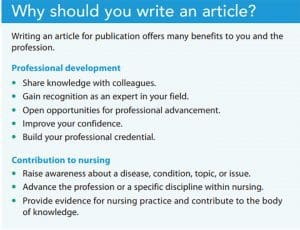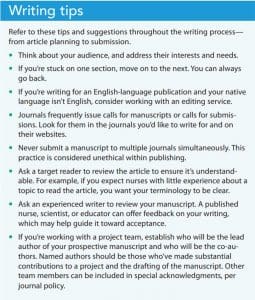Follow these tips to improve the chances your article will be published.
Editor’s note: Dissemination 101 is a series designed to help nurses share their expertise. To read other articles in the series, click here.
Writing is a win–win skill. You contribute to nursing knowledge and information dissemination while developing your confidence and building your credentials. However, writing can be hard work, and some find it intimidating. (See Why should you write an article?)


Writing for publication includes identifying and narrowing your topic, preparing to write, and the actual act of writing. It also involves formatting and submission, peer-review, and revisions. This article will cover each of these essentials, as well as provide practical tips and pointers. (See Writing tips.)


Identify your topic
Nursing and healthcare constantly evolve, rich with topics and ideas to disseminate. For previously published authors, involvement in a current project can easily ignite an idea for an article. For novice authors, frequently asked questions are “Where do I begin? What do I write about?” Here are some tips:
Start with what you do well. Are you a wound and ostomy care nurse? Write about caring for a patient with a colostomy or urostomy. Are you an experienced nurse manager? Write about improving efficiency on a unit or creating a healthy work environment. Are you a clinical instructor who made changes to adapt to a virtual setting during COVID-19? Write about your experience or share your success story.
Write about a completed evidence-based, research, or quality improvement project. One of the key steps for completing any project is dissemination. As you create your project plan, include your dissemination strategy. Many nurses submit a scholarly poster within their hospital or to local and national conferences. This may be the starting point of your article.
Schull and Saver published questions you can ask to help identify a topic, including
- What interests me?
- What will be of interest to others?
- What are trends in my specialty?
- What can others learn from what I’m doing?
Narrow your topic
Albert Einstein has been quoted as saying “If I had an hour to solve a problem, I’d spend 55 minutes thinking about the problem and 5 minutes thinking about solutions.” This same adage could apply to writing: Spend 55 minutes defining and redefining your topic and 5 minutes writing. The point is to narrow your topic. Instead of covering care for the patient with chronic liver disease, focus on caring for patients with hepatic encephalopathy. Or narrow it even further and home in on minimal hepatic encephalopathy.
Prepare to write
Preparing to write includes choosing a journal for article submission and creating an outline.
Choose a journal
The journal you submit to should match your topic or completed work. Some manuscripts are rejected not because of the writing quality but because the focus doesn’t align with that of the journal.
Start with the online and physical journals you currently read. Look for articles on topics similar to yours and review recent tables of contents. Imagine submitting a case study to a journal that hasn’t published this type of article previously, or submitting an article on a topic that was published in a recent issue. What are the odds that your submission will be accepted? All journal editors will encourage you to review their author guidelines, and many will also ask you to submit a query letter describing your idea. The editor will then provide feedback as to whether they’re interested in receiving a manuscript based on that idea.
When selecting a journal, beware of predatory publishers. If you receive an email invitation to submit your manuscript with promises of a week or less turnaround time, that’s probably a predatory journal. In 2019, Grudniewicz and colleagues published a consensus definition of predatory journals based on work by leading scholars and publishers from 10 countries: “Predatory journals and publishers are entities that prioritize self-interest at the expense of scholarship and characterized by false or misleading information, deviation from best editorial and publication practices, a lack of transparency, and/or the use of aggressive and indiscriminate solicitation practices.” The International Academy of Nurse Editors website has a list of more than 245 reputable nursing journals.
Create an outline
This simple step is essential to writing your article. Your outline should include major points and supporting ideas. The outline will help you refine your topic and organize the article. And even experienced authors recommend using mind maps and summary statements to focus and develop a topic.
Start writing
Your writing objective will drive the article’s flow and content. For example, most scientific articles are written in the IMRaD format (Introduction, Methods, Results, and Discussion). However, the format and other requirements will vary among journals—carefully review and adhere to individual journal author guidelines before submission. Here are overviews of content for two common articles—research and clinical.
Research article
Title. Think of a catchy, concise title that describes the information you’re presenting. For a research report, the title should be a declarative statement that reveals the study results.
Note in these title comparisons that the second option provides more information for the reader.
A. Standardized potassium replacement protocol
B. Safety of a nurse-driven standardized potassium replacement protocol in critically ill patients with renal insufficiency (Conley and colleagues)
A. Factors linked with sleep interruption
B. Is it noise? Factors linked with sleep interruption in hospitalized patients (Mori and colleagues)
Abstract. Abstracts aren’t required for all articles, but they are required for research reports and must contain data from the results section (if the study warrants numerical data). Describing results isn’t adequate. Data should include appropriate statistical analysis (P values or confidence intervals) to support the conclusions in the abstract. Most journals strictly enforce abstract word count and format.
Introduction. In one to two paragraphs, introduce the problem being addressed, why it’s important, and the goal of the study.
Methods. Write the methods section in a way that other researchers can replicate your study in the future. As appropriate, describe the process for institutional review board application and approval. Results. Results should be given in either text or tables and charts, but usually not both. However, if a result is particularly noteworthy, you may want to highlight it in the text in addition to the ancillary material. Provide an appropriate statistical analysis as warranted by the data. Discussion. Present the salient results, then compare your results to the existing literature. Devote the next-to-last paragraph to discuss the limitations of the study (for example, small sample size, short timeframe, or study site limitation) and explain them. The last paragraph should state why the results are significant. Conclusion. Check the specific format of your target journal. Some journals require a separate section for conclusions, whereas in others, it’s the last paragraph of the discussion. Clinical Article Introduction. Describe the purpose of your article, and include an overview of the topic and its relevance to clinical practice. In other words, why is your article important to the reader? Body. Are you presenting a new or specific procedure? Discuss the steps in the order in which they occur. If the article is about a specific condition, describe patient care, including drug therapies, and any medical interventions. Conclusion. Summarize the key points. Don’t introduce any new information. Carefully review the journal’s author guidelines, including which style guide they use (most healthcare journals use American Psychological Association or American Medical Association style); formatting instructions for figures, tables, and images (they should be high-resolution); reference and citation style; and word count. Follow the journal’s submission guidelines, which typically require that the title page, article, and figures be submitted as separate documents. Also adhere to the journal’s requirements for obtaining permission to use previously published materials, such as images. Include a succinct cover letter with your submission. When you hit the submit button, you’ve achieved a major milestone, but you’re not done yet. A critical element of the publication process is peer review. The editor will send your manuscript to at least two peer reviewers who will provide honest feedback and recommendations for improvement. The typical turnaround time from submission to decision is 6 to 10 weeks. The decision can be one of the following: accepted without revisions, accepted pending revisions (minor or major), or rejected. You also might receive a revise and resubmit decision, which doesn’t guarantee acceptance and may require a second peer review. Decision terminology may vary slightly depending on the journal. Typically, your submission will require revisions. The editor will send you a summary of the reviewers’ questions and recommendations and a due date for returning the revised manuscript. Reading negative comments can be difficult, but the intent is to help improve your article. Examine the comments and address them thoroughly. Don’t hesitate to seek clarification from the editor if feedback isn’t clear. Writing is a skill that requires time to develop, but it allows you to advance nursing knowledge and practice. Whether you’re new to writing or have written many articles, use the tools and tips in this article to start your next manuscript. Rhoda Redulla is the Magnet Program Director at NewYork-Presbyterian/Weill Cornell Medical Center in New York City, New York, and the author of Fast Facts for Making the Most of Your Career in Nursing. Alexander M. Organizing the article. In: Saver C, ed. Anatomy of Writing for Publication for Nurses. 4th ed. Indianapolis, IN: Sigma; 2021; 215-26. Conley R, Rich RL, Montero J. Safety of a nurse-driven standardized potassium replacement protocol in critically ill patients with renal insufficiency. Crit Care Nurse. 2021;41(2):e10-6. doi:10.4037/ccn2021549 Grudniewicz A, Moher D, Cobey KD, et al. Predatory journals: No definition, no defence. Nature. 2019;576(7786):210-2. doi:10.1038/d41586-019-03759-y Kozak M. Academic writing, and how to learn how to write. J Grad Med Educ. 2020;12(3):373-4. doi:10.4300/JGME-D-20-00154.1 Lefor AK, Maeno M. Preparing scientific papers, posters, and slides. J Surg Educ. 2016;73(2):286-90. doi: 10.1016/j.jsurg.2015.09.020 Linberg E. Reflections and lessons learned on academic writing and reviewing. Scand J Caring Sci. 2021;35(2):341-2. doi:10.1111/scs.12993 Mori C, Boss K, Indermuhle P, Stahl E, Chiu S-H. Shanks L. Is it noise? Factors linked with sleep interruption in hospitalized patients. Clin Nurse Spec. 2021;35(4):199-207. doi:10.1097/NUR.0000000000000606. Redulla R. Making a difference in research, evidence-based practice, and quality improvement In: Redulla R, ed. Fasts Facts for Making the Most of Your Career in Nursing. New York, NY: Springer Publishing; 2020; 81-108. Saver C. How to select and query a publication. In: Saver C, ed. Anatomy of Writing for Publication for Nurses. 4th ed. Indianapolis, IN: Sigma; 2021; 31-47. Saver C. Three steps to avoid predatory journals. Am Nurse J. June 23, 2021. Schull P, Saver C. Finding, defining and refining a topic. In: Saver C, ed. Anatomy of Writing for Publication for Nurses. 4th ed. Indianapolis, IN: Sigma; 2021; 21-30. Steinheiser MM. Compassion fatigue risk among skilled nursing facility nurses. Am Nurse J. 2021;16(6). Yarris LM, Artino AR, Deiorio NM, Ten Cate O, Sullivan G, Simpson D. Envisioning the future of academic writing. J Grad Med Educ. 2020;12(1):1-6. doi:10.4300/JGME-D-20-00006.1Formatting and submission
Peer review and decision
Revisions
Make a contribution
References

















